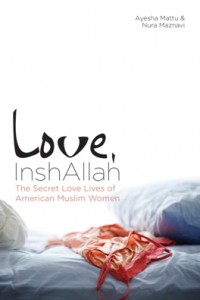 Mattu, Ayesha and Nura Maznavi. Love, InshAllah: The Secret Love Lives of American Muslim Women. Soft Skull Press, 2012. 256p. $15.95. 978-1-59376-428-9.
Mattu, Ayesha and Nura Maznavi. Love, InshAllah: The Secret Love Lives of American Muslim Women. Soft Skull Press, 2012. 256p. $15.95. 978-1-59376-428-9.
Though Love, InshAllah contains very few stories from a LGBT perspective (I counted only two), I believe that this work is of interest and use to those teaching LGBT issues. This is a diverse collection of American Muslim women’s accounts of falling in love and marrying (and sometimes getting divorced), including converts to Islam, those raised as Muslims (in families of varying degrees of observance), and American Muslims from a variety of ethnic, racial, and national backgrounds.
I suspect that one goal of the editors is to present a common American idea of the “other” (the immigrant or religious, racial or ethnic other) as less of a stereotype and as “fully American,” despite perceived fundamental differences. This was done in the 19th and 20th centuries for American Catholics and American Jews and, of course, throughout the 20th and now 21st centuries for LGBT people. It is often done by presenting, in novels, plays, movies, and in this case, first-person narratives, the “other” as having the “same” desires and loves “as us” (in fact, the word “secret” in the title appears to refer to the fact that most Americans know little or nothing about Muslim American women’s interior lives). This is a rhetorical gesture with which LGBT people can identify.
Here some of the issues are “non-traditional marriage” (polygamous ones), “coming out of the closet” (as Muslim), being rejected by one’s family (for converting or for marrying a non-Muslim or the “wrong kind” of Muslim), and negotiating respect for religious traditions while framing one’s own interpretations of them (an issue shared by religiously inclined LGBT individuals and perhaps by many Americans regardless of background or orientation).
The collection, therefore, might be useful for courses in which LGBT issues are raised to show similarities across experiences. It might also ignite discussions about romantic love as a social or cultural construct or a possible universal experience, albeit one colored by cultural influences and expectations. Issues of assimilation, of adapting to the majority culture while retaining a separate identity, or changing the majority culture might be raised. The book could help spur discussions about the importance of religion in the experience of many Americans as well as how a pluralistic society comes to both respect religion’s role while not allowing any religion to deny human and civil rights to others, including LGBT others.
I strongly recommend it for libraries in colleges where LGBT issues are taught as well as for public libraries.
Reviewer: David Woolwine
Axinn Library, Hofstra University